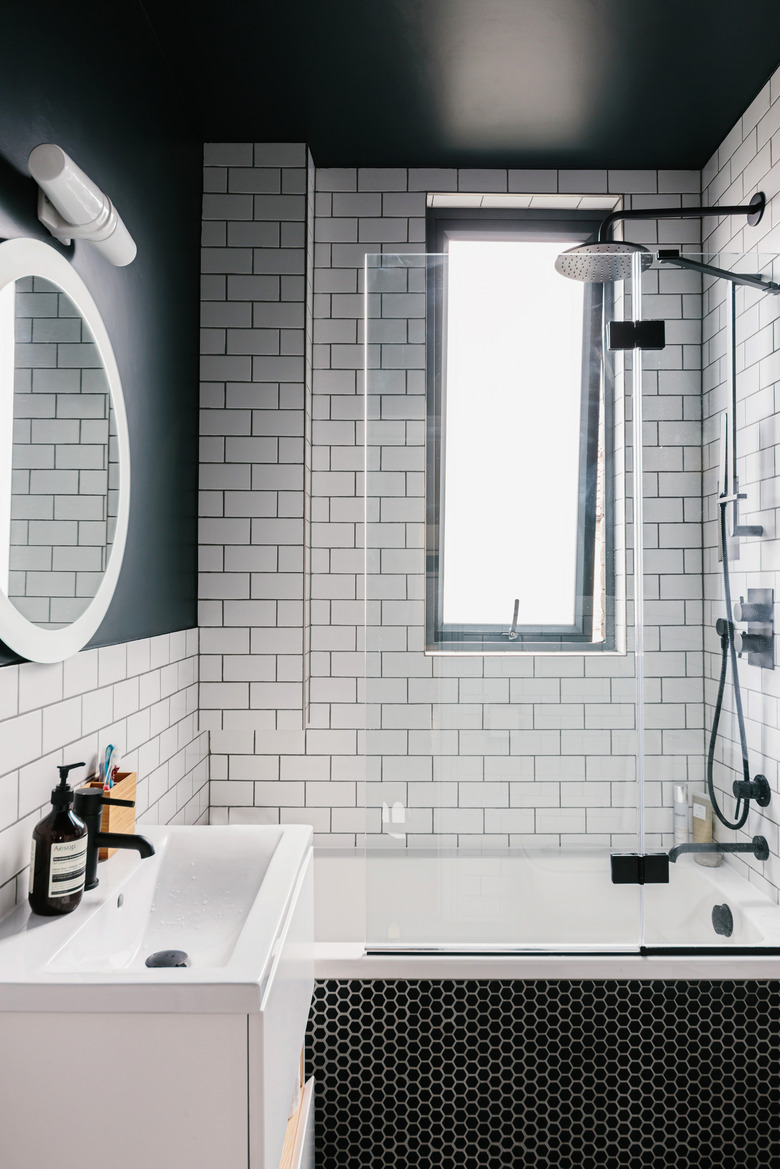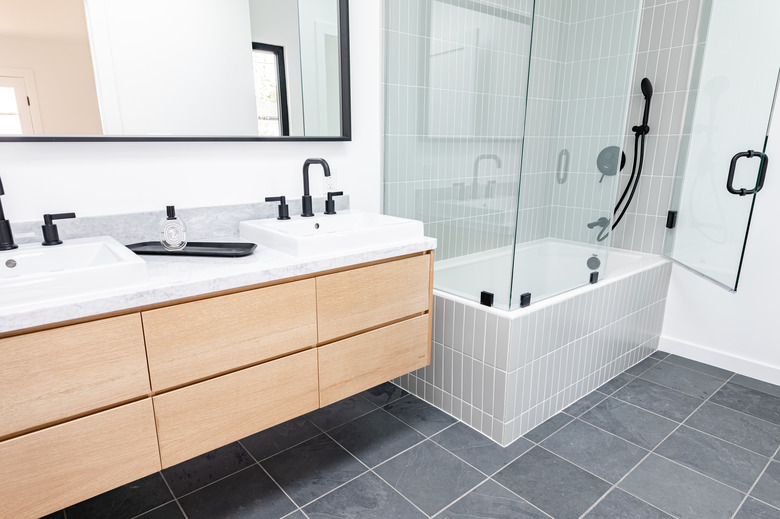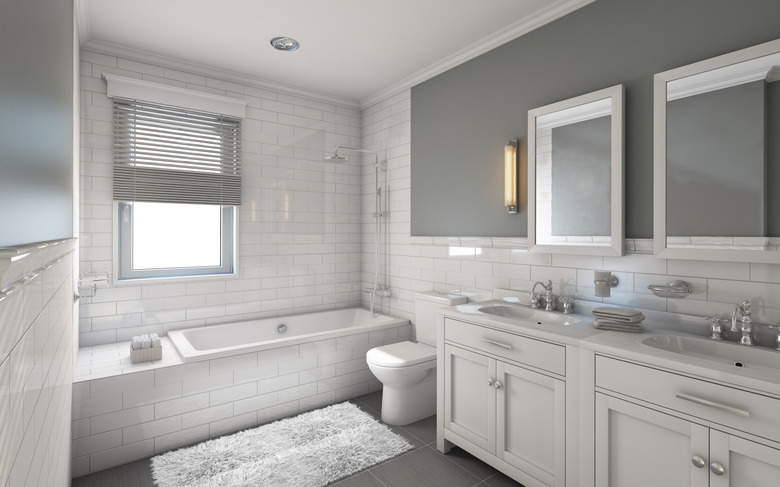Drop-In Bathtubs: What You Need To Know
Drop-in bathtubs can add an air of elegance to a bathroom that can't be rivaled by a standard alcove tub. They can fit in with just about any decor, and since the rim reduces splashing, they are a great option for those who like deep soaks. Even with all its benefits, there are some downsides to the drop-in bathtub, and you should give a lot of thought to this choice before you buy a tub.
What Is a Drop-In Tub?
What Is a Drop-In Tub?
A drop-in tub is a tub basin with no finished sides that needs to be "dropped" into a base. Once a drop-in tub has been installed, the only part of the tub that is visible is the interior and the rim. The base enclosure around the tub is called a surround, deck or platform. This is commonly recessed into an alcove, but it can be a freestanding structure or can even fit directly into the floor for a floor-level tub. Surrounds can be made with nearly any water-safe building material, allowing drop-in bathtubs to perfectly match any bathroom decor style.
Other Styles of Tubs
Other Styles of Tubs
There are many other bathtub styles from which to choose, and it pays to know all available options before choosing the right style for your home. The alternatives to a drop-in tub include:
- Undermount: They are similar
to drop-in tubs, but they do not feature a rim that sits above the surrounding
base. Instead, the edge of the base covers the lip of the tub so the only part
of the tub that is visible is the inside. It is possible to install a drop-in
tub in an undermount style, but there are also bathtubs sold for undermount
installation exclusively. - Alcove: Like a
cross between drop-in and freestanding tubs, these are specifically designed to
sit in an alcove and are the most common form of tub, with the majority
installed in bathtub/shower combinations. An alcove tub will have three
unfinished sides that sit against the walls of the alcove and one finished side
that provides support and covers the area between the walls, floor and tub. - Corner tubs: While
you can install a drop-in or undermount tub in a corner, there are also special
alcove tubs designed for corners that feature two finished sides rather than
just one. - Freestanding tub:
When a tub doesn't need to be set in a base or against a wall, it is a
freestanding tub. While these come in all shapes and sizes, some of the best-known freestanding tubs are clawfoot tubs that have support legs underneath
them. These are one of the most popular options for those looking for a deep soaking
bathtub with a classic design.
Pros and Cons of Drop-In Tubs
Pros and Cons of Drop-In Tubs
Once you're aware of the different types of tubs available, you can start comparing the benefits and drawbacks of one style over the others to determine which one is right for you. Some advantages of drop-in tubs include:
- Drop-in bathtubs are bigger and offer more style choices than alcove
tubs. - They have practically unlimited design options when it comes to the base
and tub, including flexibility with tub placement and installation height. - The raised rim keeps in water better than other undermount or alcove tubs, making
these tubs a preferred design for those seeking deep soaker bathtubs. - There are nearly unlimited design options when it comes to the combination of the custom-built surround and the tub.
- Drop-in tubs are easy to clean since you don't need to clean the tub exterior
past the rim. - Bases can be fit with storage drawers, cabinets or shelves,
maximizing storage in the bathroom. - Drop-in bathtubs are inexpensive to replace the tub within the base.
On the other hand, there are some downsides to installing a drop-in tub. These can include:
- These types of tubs require some kind of surrounding base to provide stability
and visual appeal. These can often be expensive and may negate much of the
savings from the low cost of the tub itself. - Drop-in tubs are more difficult to access plumbing compared to freestanding
tubs but generally easier to access than alcove tubs (as long as the base has a
removable access panel). - They should generally not be used with a shower, as it is nearly impossible to push the water over the rim and back into the tub, leaving sitting water on the surround. This can be resolved if a drain system is added to the surround or if a door is installed completely inside the tub rim, although both setups are uncommon.
Sizes and Shapes
Sizes and Shapes
Drop-in tubs come in a wide array of shapes and sizes, making them a good fit for just about any bathroom. While the tubs are usually sold in standard rectangle shapes like most tubs, you can also buy a circle or oval bathtub. If you want something more unique, triangles, hearts and hourglasses are also available.
Quality Bath says common sizes can range from only 35 inches to a massive 86 inches long, from only 20 inches all the way to 84 inches wide and from just 12 inches to 41 inches deep. This means you can use a particularly deep tub with a small surface area in a space you may not normally expect to fit a bathtub, or if you have the space, you can get a multiperson whirlpool soaking tub.
Choosing the Right Materials
Choosing the Right Materials
As for materials, drop-in tubs are most commonly found in the same acrylic material as most bathtubs, which is both lightweight and easy to clean. For something with more visual appeal, copper offers a uniquely timeless look, natural antimicrobial properties and durability. Alternatively, cast iron tubs are particularly sturdy and have excellent heat retention properties. For those looking for something more affordable, fiberglass is durable and lightweight, making it a great option for upstairs bathrooms.
It's also possible to get these bathtubs in other materials, including solid stone, man-made stone or solid surface. Most of these options come in a wide array of colors to compliment your bathroom decor.
As you might expect, the price of these tubs will vary widely based on the size, style and material you select. Most homeowners should be able to find a high-quality drop-in bathtub for around $700, and you can find low-end models for $500, but more luxurious models can cost over $10,000. Naturally, designs with extra amenities will cost more, so if you want a deep-soak, whirlpool bathtub with an arm rest on each side, don't be surprised if it costs hundreds more than a stripped-down model.
As for the tub base, the surface may be decorated with a wide array of materials as well, although the material should ideally be waterproof or at least treated with a water-resistant finish. Popular options include natural stone, manufactured stone, ceramic tiles, solid surface and wood. Because a base is required with a drop-in tub, it's important to budget for this as well as for accessories like faucets when considering the overall price of the project.
Installing a Drop-In Tub
Installing a Drop-In Tub
The installation process will vary based on where you plan to install your bathtub as well as the material. It can be fitted in the corner of a room, an alcove or in the center of the bathroom and may be built into a platform, semirecessed or flush with the floor. Installing a drop-in tub is not a DIY project for most people, so unless you're particularly adept at home improvement projects, you'll want to hire an experienced contractor to install the tub for you. Always figure out the size of your base area before purchasing your tub to make sure your tub will fit properly.
The first step of installation is to prepare the plumbing. If your tub has a reversible drain, meaning it has a drain on one side rather than a center drain, you'll need to decide which direction the tub should sit. You'll also need to decide where the faucet should be fitted.
Once the plumbing setup is complete, it's time to build the wooden frame that will support the tub. This will need to be at least large enough to support the rim of the tub on all sides, but you may wish to build a larger platform structure, particularly if your platform is tall enough to require stairs. Always leave an access panel when possible in case something goes wrong with the plumbing. If you are using a whirlpool tub, ensure you leave room for the motor and an access panel for repairs.
When the frame is completed, add the finish materials, running them all the way up to the opening. Next, install the plumbing accessories, such as the drain and faucet, to the tub and/or base. You won't need to connect these yet unless you failed to leave an access panel, but you'll want them ready to go when you set the tub in the base. Some tubs, particularly those that are very heavy, may need a mortar base. Lay the mortar down just before setting in the tub.
Finally, lower the tub into place and ensure it is level. Once the mortar has dried, make your final plumbing connections if you have not done so already. Secure the tub according to manufacturer instructions and then caulk around the rim.


